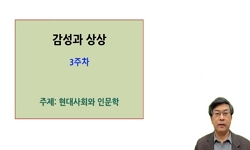Although literary history has attempted overwrite and erase amatory fiction of earlier eighteenth-century women novelists, many elements of this popular genre were rewoven into the more elevated novels and became integral part of the English novel. In...
http://chineseinput.net/에서 pinyin(병음)방식으로 중국어를 변환할 수 있습니다.
변환된 중국어를 복사하여 사용하시면 됩니다.
- 中文 을 입력하시려면 zhongwen을 입력하시고 space를누르시면됩니다.
- 北京 을 입력하시려면 beijing을 입력하시고 space를 누르시면 됩니다.
https://www.riss.kr/link?id=A82604676
- 저자
- 발행기관
- 학술지명
- 권호사항
-
발행연도
2004
-
작성언어
-
- 주제어
-
KDC
843.05
-
등재정보
KCI등재후보
-
자료형태
학술저널
-
수록면
123-138(16쪽)
-
KCI 피인용횟수
0
- 제공처
-
0
상세조회 -
0
다운로드
부가정보
다국어 초록 (Multilingual Abstract)
Although literary history has attempted overwrite and erase amatory fiction of earlier eighteenth-century women novelists, many elements of this popular genre were rewoven into the more elevated novels and became integral part of the English novel. In this paper, I argue that widely divergent as they may seem the sentimental novel and amatory fiction share much in common. I attempt to show how the eroticized body of Haywood`s amatory fiction is not far different from the sensitized body of the sentimental novel and the pleasures to be had from reading the two types of novel stand much closer in nature than is generally supposed. I have taken as my examplary text Haywood`s Love in Excess (1719). Both types of novels are built on a series of scenes in which the eroticized/sensitized body is displayed before the onlooker, and in order to describe this body, Haywood makes extensive use of words and expressions which later became key terms in the novels of sensibility. Love in Excess sees the feminization and reformation of the male hero from a libertine to a sentimentalized lover, and love becomes to amatory fiction what active sympathy is to the novel of sentiment. I attempt to establish the link between erotic arousal and emotional arousal and argue how these reactions are fundamentally similar in that they form part of what has been called the eroticized reading process, which laid the novel open not only to the popularity it increasingly enjoyed but also to censure.
참고문헌 (Reference)
1 "“Ev'ry Woman Is at Heart a Rake" 27-74, 1974
2 "“Collusive Resistance: Sexual Agency and Partisan Politics in Love in Excess.” Kirsten and Bocchicchio" 48-68,
3 "and Incapable of Defense’ The Hysterics of The British Recluse" 95-114,
4 "Women’s Amatory Fiction from 1684-1740" Clarendon Press 1992
5 "Women and the rise of the novel: sexual prescripts.” Women and Literature in Britain 1700-1800. Ed. Vivien Jones." Cambridge UP 197-216, 2000
6 "The Senses in Social Context" 1993
7 "The Progress of Romance" 1930
8 "The Passionate Fictions of Eliza Haywood: Essays on Her Life and Work." UP of Kentucky 2000
9 "The Origins of the English Novel U of Pennsylvania P" 1983
10 "The Language of Feeling in the Eighteenth Century" 1988
1 "“Ev'ry Woman Is at Heart a Rake" 27-74, 1974
2 "“Collusive Resistance: Sexual Agency and Partisan Politics in Love in Excess.” Kirsten and Bocchicchio" 48-68,
3 "and Incapable of Defense’ The Hysterics of The British Recluse" 95-114,
4 "Women’s Amatory Fiction from 1684-1740" Clarendon Press 1992
5 "Women and the rise of the novel: sexual prescripts.” Women and Literature in Britain 1700-1800. Ed. Vivien Jones." Cambridge UP 197-216, 2000
6 "The Senses in Social Context" 1993
7 "The Progress of Romance" 1930
8 "The Passionate Fictions of Eliza Haywood: Essays on Her Life and Work." UP of Kentucky 2000
9 "The Origins of the English Novel U of Pennsylvania P" 1983
10 "The Language of Feeling in the Eighteenth Century" 1988
11 "The Culture of Sensibility Sex and Society in Eighteenth- Century Britain U of Chicago P" 1992
12 "Sentimental Novels.: The Cambridge Companion to the Eighteenth Century Novel." Cambridge UP 236-254, 1996
13 "Popular Fiction Before Richardson" Clarendon Press 1700-1739, 1992
14 "Paraleipomenon or The Thing Left Out: Women’s Bodies as the Location of Experience. Passionate Encounters in a Time of Sensibility" U of Delaware P 89-105, 2000
15 "Obscene Readings: Transport in the Eighteenth-Century Novel." 347-371, 1999
16 "Love in Excess; or" Broadview Press 1994
17 "Licensing Entertainment: The Elevation of Novel Reading in Britain," U of California P, 1684-1750, 1998
18 "Generation and the Politics of Reproductive Biology ” The Making of the Modern Body Sexuality and Society in the Nineteenth Century U of California P" 1-41, 1987
19 "Functions of Plot in Eighteenth-Century Novels U of Chicago P" 1990
동일학술지(권/호) 다른 논문
-
Rethinking Wordsworth`s "Twaddling Stuff": Sympathy and Narrative in Eliot`s Adam Bede
- 근대 영미소설 학회
- 조희정 ( Hee Jeong Cho )
- 2004
- KCI등재후보
-
- 근대 영미소설 학회
- 조애리 ( Ai Lee Cho )
- 2004
- KCI등재후보
-
헨리 제임스의 『비극적 시신』의 여배우 미리엄: 재현적 연기와 탈근대적 여성성
- 근대 영미소설 학회
- 정소영 ( So Young Jung )
- 2004
- KCI등재후보
-
- 근대 영미소설 학회
- 손정희 ( Jeong Hee Sohn )
- 2004
- KCI등재후보
분석정보
인용정보 인용지수 설명보기
학술지 이력
| 연월일 | 이력구분 | 이력상세 | 등재구분 |
|---|---|---|---|
| 2026 | 평가예정 | 재인증평가 신청대상 (재인증) | |
| 2020-01-01 | 평가 | 등재학술지 유지 (재인증) |  |
| 2017-01-01 | 평가 | 등재학술지 유지 (계속평가) |  |
| 2013-01-01 | 평가 | 등재학술지 유지 (등재유지) |  |
| 2010-01-01 | 평가 | 등재학술지 유지 (등재유지) |  |
| 2008-06-04 | 학회명변경 | 영문명 : The Korean Society Of British And American Fiction To 1900 -> The Korean Society of British and American Fiction |  |
| 2008-05-29 | 학술지명변경 | 외국어명 : The British and American Novel -> British and American Fiction |  |
| 2008-01-01 | 평가 | 등재학술지 유지 (등재유지) |  |
| 2006-01-24 | 학술지명변경 | 외국어명 : British and American Fiction to 1900 -> The British and American Novel |  |
| 2005-01-01 | 평가 | 등재학술지 선정 (등재후보2차) |  |
| 2004-01-01 | 평가 | 등재후보 1차 PASS (등재후보1차) |  |
| 2003-01-01 | 평가 | 등재후보학술지 유지 (등재후보2차) |  |
| 2002-01-01 | 평가 | 등재후보 1차 PASS (등재후보1차) |  |
| 2000-07-01 | 평가 | 등재후보학술지 선정 (신규평가) |  |
학술지 인용정보
| 기준연도 | WOS-KCI 통합IF(2년) | KCIF(2년) | KCIF(3년) |
|---|---|---|---|
| 2016 | 0.24 | 0.24 | 0.21 |
| KCIF(4년) | KCIF(5년) | 중심성지수(3년) | 즉시성지수 |
| 0.2 | 0.17 | 0.758 | 0.17 |





 KCI
KCI KISS
KISS






